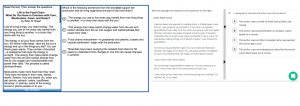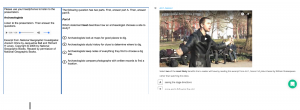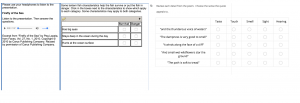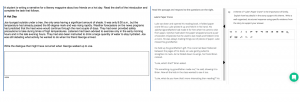Edulastic: Authentic M-STEP Prep
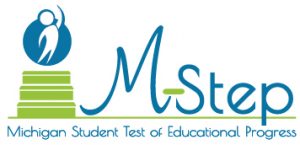 With test prep season beginning and the M-STEP looming, teachers can become frustrated because there are not many M-STEP released items to use with students, in order to help them practice the item types. The items that are released are likely not related to the content being taught at the time, and, therefore, feel very out of context and inauthentic to students.
With test prep season beginning and the M-STEP looming, teachers can become frustrated because there are not many M-STEP released items to use with students, in order to help them practice the item types. The items that are released are likely not related to the content being taught at the time, and, therefore, feel very out of context and inauthentic to students.
I recently came across a web tool called Edulastic that helps address this problem. Edulastic allows teachers to create assessments that mimic the look and feel of the M-STEP; they include online, technology-enhanced formative, interim, benchmark, and summative assessments. Some of the features of Edulastic include:
- Instant and real-time data on student performance, in the form of many types of reports
- The ability for teachers to create their own technology-enhanced items (30+ question types, including embedded multimedia items)
- Google Classroom syncing
- An item bank of over 80,000 standards-aligned items, some of which are user created, and some of which are from verified sources, like SBAC and PARCC
- Free account for teachers; districts can purchase a district account with more features
Linking Test Prep with Coursework
Edulastic’s data reporting seems to be very robust and could benefit teachers and students in the long run. But the web tool’s immediate benefit to teachers is that it allows them to create technology-enhanced questions about the content they are teaching at any given time. Instead of teachers giving a traditional multiple choice test, Edulastic can help teachers mimic M-STEP style in any test at any time, with items like hot text, editing a passage, drag and drop, matching tables, re-sequencing, and more.
Below you will see a few comparisons of what M-STEP released items look like compared with what teachers can create with Edulastic. M-STEP is on the left, and Edulastic is on the right. You can click the paired images to enlarge them in a new window.
Sentence Response: students select a sentence(s) from a passage to answer a question
Passage Based: students read a passage and answer questions about it
Multiple Select: students must select more than one answer option
Multimedia Embedded: video or audio is included
Matching Tables: students select features in a table
Essay/Constructed Response: students must type a response to the question
Being able to create these types of questions for any content means that test preparation doesn’t have to be decontextualized and something “extra” we have to fit in. Instead, this practice can happen at anytime throughout the year on any given assessment. Rather than kids’ having to learn to navigate new types of questions shortly before taking a high-stakes assessment, they can practice all year. Not to mention that these question types often require a higher level of thinking, so they are more than just test prep–they are good assessment practices.
 Jianna Taylor (@JiannaTaylor) is the ELA Curriculum Coordinator for the West Bloomfield School District. Prior to this role, she was a middle school ELA and Title 1 teacher. She is a MiELA Network Summer Institute facilitator and is an Oakland Writing Project Teacher Leader. Jianna earned her bachelor’s degree from Oakland University and her master’s degree from the University of Michigan. She also writes reviews of children’s books and young adult novels for the magazine School Library Connection.
Jianna Taylor (@JiannaTaylor) is the ELA Curriculum Coordinator for the West Bloomfield School District. Prior to this role, she was a middle school ELA and Title 1 teacher. She is a MiELA Network Summer Institute facilitator and is an Oakland Writing Project Teacher Leader. Jianna earned her bachelor’s degree from Oakland University and her master’s degree from the University of Michigan. She also writes reviews of children’s books and young adult novels for the magazine School Library Connection.


